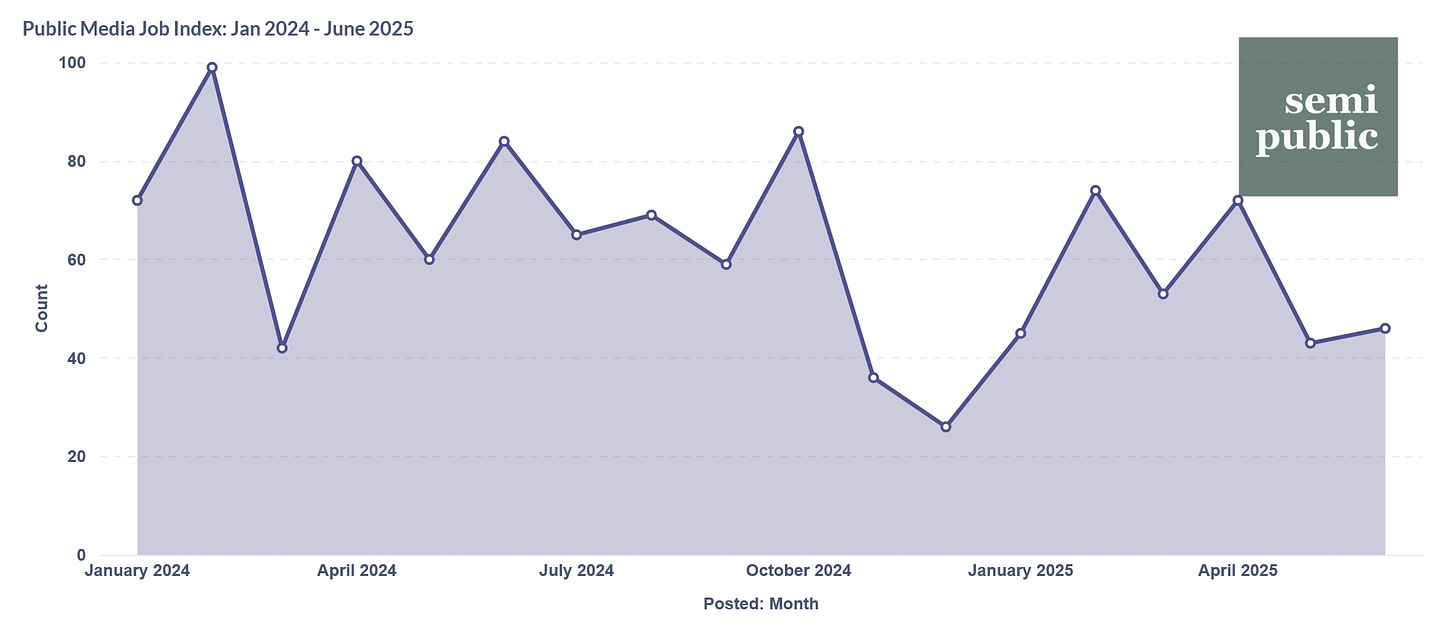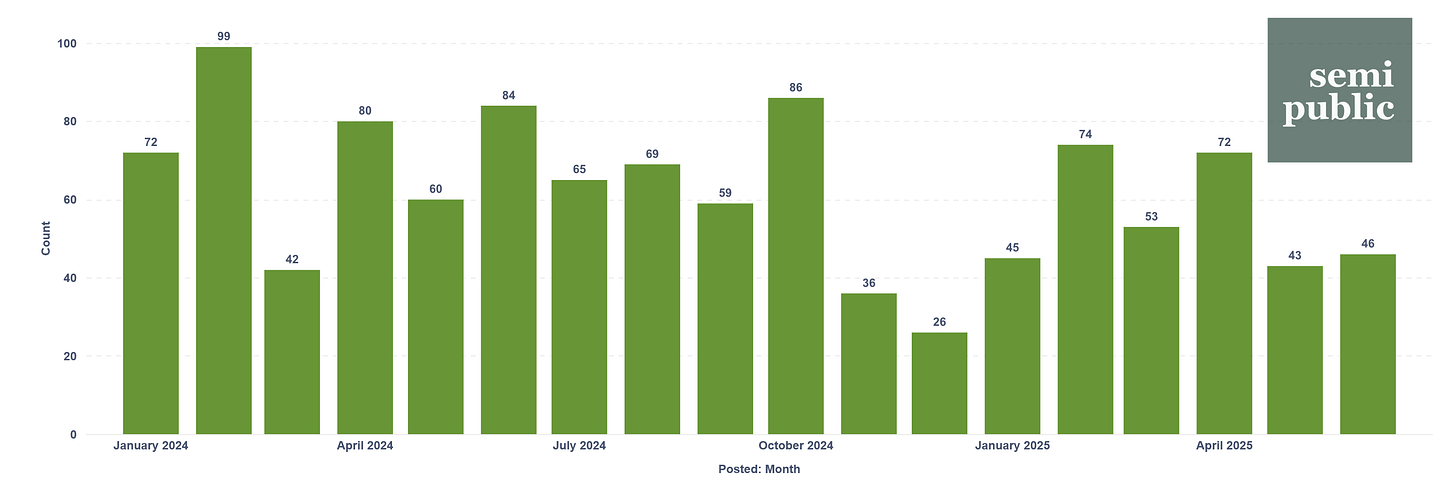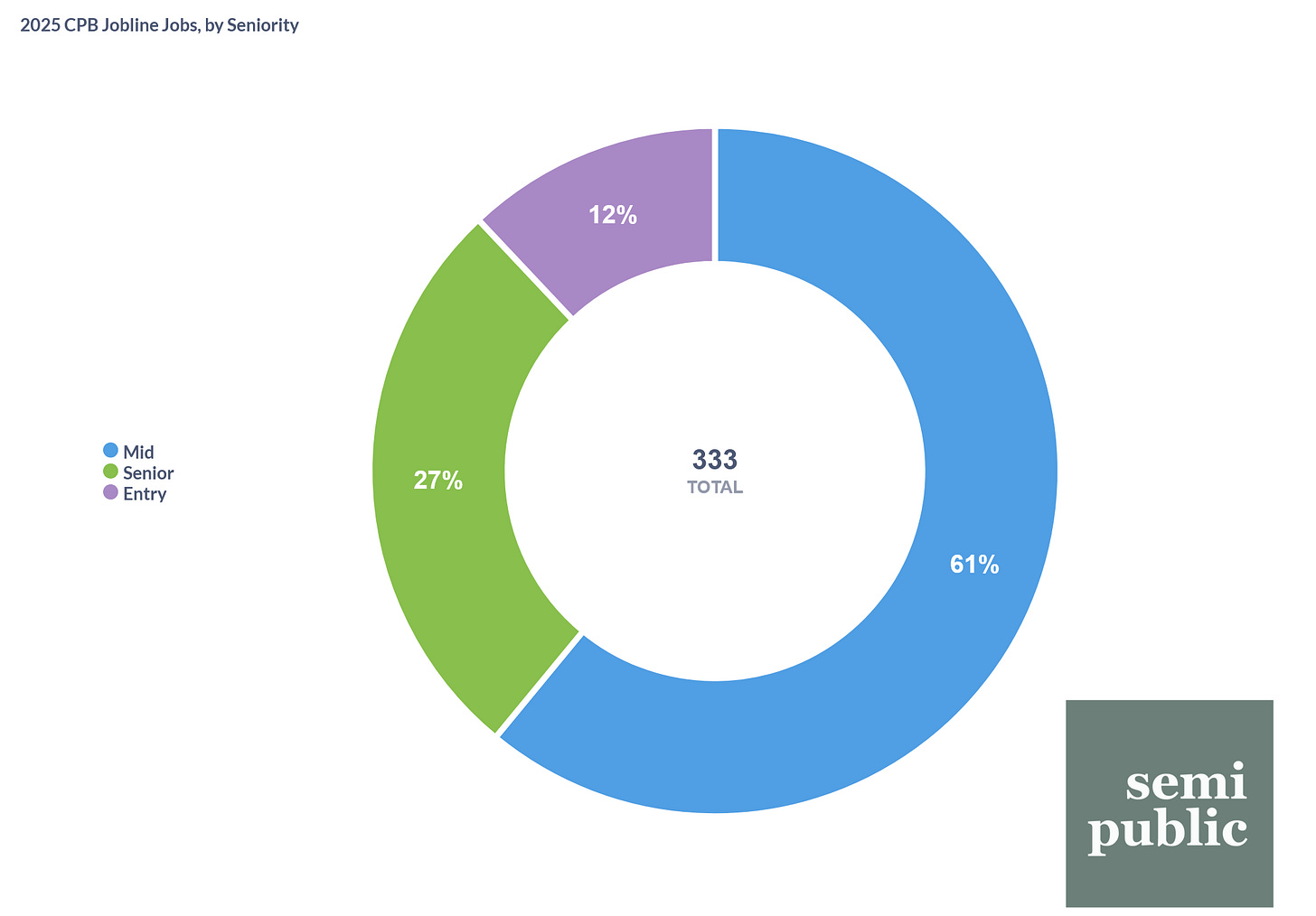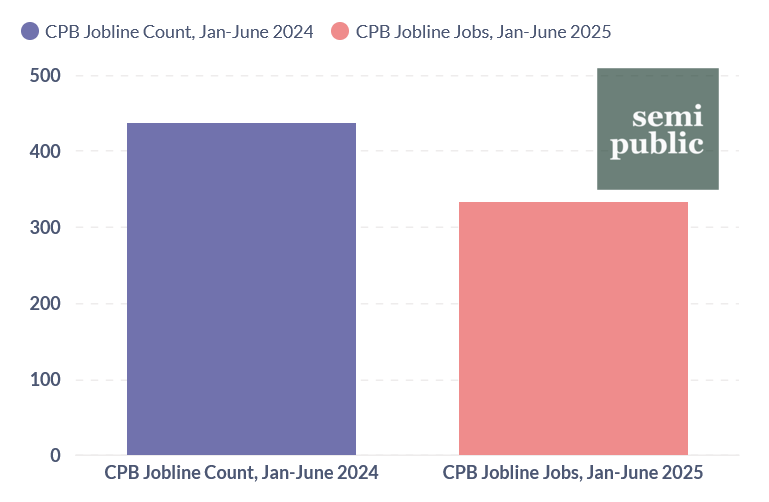Introducing the Public Media Jobs Index: June 2025
Public media jobs listings are down 24% compared to this time last year.
Last week was a bit of a rollercoaster for me. On Tuesday, I was pleasantly surprised to hear NPR and WAMU’s 1A devote a whole hour to the topic of at-risk public media stations, prominently featuring the insights I’ve reported on from Semipublic’s dataset, ahead of the Senate Appropriations Committee hearing on the White House’s rescissions package. It was a wonderfully illuminating discussion about what’s truly at stake following the loss of federal funding for public media. You can hear the expert panel they assembled, as well as some thoughts from me later on in the hour, here.
Additionally, the Senate Appropriations Committee sent some hopeful signals regarding rescinding funding for the Corporation for Public Broadcasting. Here’s what Senator Collins, the committee’s chair, said in an opening statement:
The second area I want to highlight is the proposed elimination of advance appropriations to the Corporation for Public Broadcasting. The vast majority of this funding—more than 70 percent—actually flows to local television and radio stations. In Maine, this funding supports everything from emergency communications in rural areas to coverage of high school basketball championships and a locally produced high school quiz show.
…
I understand, however, the concern about subsidizing the national radio news programming that for years has had a discernibly partisan bent. There are, however, more targeted approaches to addressing that bias at [NPR] than rescinding all of the funding for the Corporation for Public Broadcasting.
Unfortunately, later that day, I came down with a bout of the flu. It’s been so intense that I had to cancel my plans to write for Semipublic last week and am still a bit too weak to type for very long.
That’s all to say that today’s post will be somewhat short. But still informative!
Methodology
If you read my breakdown of Sesame Street’s finances (and if you haven’t, why haven’t you?), you’ll have noticed that I began using n8n, the self-hosted automation tool, to begin scraping webpages around April or May. My first big success was scraping all of the 2024 CPB grant data, but the second was automatically scraping CPB Jobline, the public media job board run by the corporation, every time a new listing was added.
Here’s how it works: A self-hosted instance of changedetection.io running on the Semipublic server stack looks for changes to the Jobline webpage where jobs are listed in order of newest postings. When a change is detected (a listing is added or removed), changedetection.io sends a webhook to a self-hosted instance of n8n on the same stack. The webhook triggers n8n to fetch the HTML of the CPB Jobline website, then extracts job listing data into an array based on CSS selectors. n8n then converts the array into a table, cleans up the data (removes URLs from job titles, separates cities from states, etc, using regex filters), and converts the posted date to ISO 8601. Then, one by one, n8n will match the job listing against existing entries in a PostgreSQL database, inserting new entries and skipping existing ones. Then, a completion message is sent via Pushover to my phone.
Additionally, I went back via The Wayback Machine to archived snapshots of the job page from throughout 2024 and manually fed each page into n8n in order to get last year’s job data. I consider this 2024 data to be at least 95% complete.
In addition to job title, date posted, employer, and location scraped from the listings, I’ve added (manually this time, automatically in the future) three levels of job seniority: Entry, Mid, and Senior. These are subjective based on my personal understanding of public media job titles, but all executive level jobs, jobs with the word “senior” in them, and Director-level jobs are categorized as Senior-level, while internships, most fellowships, and assistant jobs are categorized at Entry-level. Everything else is Mid-level. Note that Mid-level also includes all managers below “senior manager.”
Finally, I went back (again, manually, but will be automated) to compare listings with identical titles and employers but different posting days. It makes sense for generic job titles to be reused at different points of the year, and I otherwise have no way of knowing if job listings with identical titles are reposts or not, so I decided to only delete duplicate listings posted 30 days or fewer after the original.
I’ve also been scraping publicmediajobs.org from Current since the middle of June, but their job listings are not archived through The Wayback Machine since their bot security is more robust than CPB’s. Therefore, the first full month-to-month comparison with publicmediajobs.org listings will have to be for August. Luckily, there is much overlap between the two public media job sites.
It should also be noted that NPR, PBS, PRX, and APM listings don’t make it onto the CPB Jobline, making this a representation of stations only.
If you’re interested in the full n8n workflow, I’ve posted it to Semipublic’s GitHub repository.
The Public Media Job Economy
For having an outsized impact on the country as a whole (or at least I think so, anyway), public media is a very tiny job economy: Since the beginning of 2024, the over 580 organizations that make up public media only posted 1,111 job openings, 333 of which were posted in 2025.
Of those 333 jobs posted so far in 2025, nearly 2/3rds were what I consider to be mid-level jobs, which includes titles like hosts, reporters, and membership managers. On the opposite end, there were only 40 job listings across all stations that were either internships, fellowships, or what I consider to be early-career, meaning that they require little to no professional experience.
Compare the number of entry-level listings in 2025 so far, 40, to senior-level listings, 90. This discrepancy suggests to me that public media, in part, has an early talent development problem. We are already hearing stories about how difficult the job market is for new grads, imagine how difficult it is for, presumably, thousands of public media hopefuls to wrestle for 40 open slots at stations across the entire country.
Let’s turn our attention back to 2024. If we compare total job listings between January and June of that year with the same period in 2025, we see a remarkable difference of 104 jobs, or a 24% drop. That drop seemed to start in November of 2024, when job listings plummeted to just 36 that month and 26 in December.
Indeed, even a side-by-side comparison of both Junes shows a nearly 50% drop in station job listings. June was the #3 most populous month for listings in 2024, while the month has already slipped to #4 with 6 months still remaining in the year.
Certainly, two years of data isn’t enough to identify a trend, but can we attribute this year-over-year drop in job listings to the current public media federal funding threat? We see a large drop-off after the election, but that could be normal post-election calm. Both February and April of 2025 had hiring upticks, but none of those peaks and valleys have risen to their 2024 levels.
As the Public Media Job Index matures, so will the answers to our questions. For now, we’ll wait to see what the next four weeks holds in store for public media job seekers.
As always, here’s a shareable dashboard containing this newsletter’s graphs and data. If you enjoyed this article, please leave a like. It’s very much appreciated.








